up
also up
L-h ![]() and also
and also
![]()
![]()
Lh-h ![]()
Down
also down
H-l ![]()
Hl-l ![]()
Level
n.a.
level ![]()
n.a.
A snapshot of an IViE transcription.
This labelling guide describes the structure and application of the IViE system for prosodic labelling.
IViE stands for 'Intonational Variation in English', and is pronounced like the woman's name 'Ivy'. IViE
is based on ToBI, the current standard for prosodic labelling of English intonation (Silverman et al. 1992,
Beckman and Ayers, 1997), but unlike the original
ToBi, IViE allows for directly comparable transcriptions of several varieties of English in a single
labelling system. Additionally, IViE transcriptions capture rhythmic differences between varieties,
and differences in phonetic realisation.
In the IViE system, prosody is transcribed on three levels:
(a) rhythmic structure
(b) acoustic-phonetic structure
(c) phonological structure
The three levels allow us to transcribe rhythmic variation,
variation in pitch accent realisation, and variation in tune structure.
Cambridge English and Bradford Punjabi
English, for instance, differ in their rhythmic structure (Grabe et al., to appear).
Leeds and Newcastle English differ in the phonetic realisation
of pitch accents (Grabe, Post, Nolan and Farrar, 2000).
Finally, Cambridge and Belfast English differ in their phonological structure.
Belfast English speakers produce pitch accents which are not part of a
Cambridge speaker's inventory (Grabe et al., to appear).
Back to the top
1.1 How IViE transcriptions are made
IViE transcriptions are made step-by-step. Labellers begin by deciding on the location of rhythmically
strong syllables. Rhythmically strong syllables can be accented or unaccented and are labelled 'P' (prominent). The label
is placed in the middle of the strong vowel.
Next, labellers transcribe the pitch movement surrounding syllables labelled as prominent. This
transcription is made on the phonetic tier or target tier. Clearly, there are many acoustic-phonetic
aspects of f0 one could label (e.g. pitch range, declination, register, alignment). In the IViE
system, the phonetic transcription is chiefly about alignment. Labellers transcribe the shape
and alignment of f0 patterns relative to the location of strong
(accented) syllables in the text.
The domain for an alignment transcription is the Pitch Accent Implementation Domain or ID.
More information
on the ID is given in section 3.3.1 below.
Finally, labellers come up with phonological classifications. These are made on the tone tier.
Note that phonological analysis in intonation is difficult and
controversial, and there are no widely accepted tests (whether experimental or introspective) for phonological category
membership.
Therefore, on the IViE tone tier, transcribers are provided with a toolkit for phonological analysis.
The labels given on this
tier do not constitute a phonological analysis of any particular variety of English.
Instead, users work with a pool of
labels from which they choose different subsets for different varieties of English. In other words, IViE provides
the labels, and labellers may use these to draw up phonological systems for different varieties of English.
The resultant variety-specific systems are directly comparable because we have imposed one constraint
on the possible form labels take: all tonal morphemes in the pool are left-headed, and because we have added an
option that many other two-tone systems do not have: intonation phrase boundaries do not have to be associated
with a high or a low tone, but can be left unspecified (Grabe, 1998b, boundary specifications are H%, L% or % (no change))
Back to the top
1.2 Comparative approach to phonological analysis
In our work on varieties of British English, we take a comparative approach to intonation analysis.
Our corpus contains directly comparable data from twelve speakers of each variety of
English recorded, in a range of speaking styles. Therefore, we not need to
label utterances from a particular speaker in isolation. We can compare the intonational structure of
utterances produced in similar or identical context and produced with similar speaker
intent. All IViE labels are assigned in this way. We start our work as follows:
(1) We draw up a first set of hypotheses about variety-specific intonation systems on the
basis of read speech (controlled sentences, read passage). Our read speech data provide the starting point
because these data contain directly comparable intonation
contours produced by different speakers in identical contexts.
(2) Then we compare the contours produced in read speech with semi-spontaneous speech data (a retold version of our reading passage).
In the semi-spontaneous data, speakers produce lexical items which have also been produced in the reading passage.
We can compare the intonation contours produced around these items directly across the two speaking styles and across speakers.
(3) Next, we transcribe Map Task data (goal-directed interaction). These data allow for a comparison of contours
on the same lexical items across speakers and an investigation of deaccenting and reaccenting. We can also check whether
speakers produce contours in the Map Task which they do not produce in other speaking styles.
(4) Finally, we label conversational data, and this is the most difficult set of data to label (greatly increased
range of delivery, speaker overlap, two overlapping fundamental frequency traces). The information about
variety-specific intonation
structures that we have collected from the other speaking styles is helpful here.
(5) On the basis of our comparisons, we draw up an language-specific inventory of pitch accents and boundary tones.
Back to the top
2. Technical information
Like ToBI, IViE works in conjunction with xwaves(TM), a commercial software package which used to be
available from Entropic. IViE labelling can also be carried out using
PitchWorks,
or any other signal processing package which allows the user to
add text labels (e.g.
PRAAT or
wavesurfer) or with pen and paper.
Xwaves runs under UNIX, and the IViE labelling tool displays
the speech pressure wave, a labelling template and the fundamental frequency trace. If you place the cursor
into one of the labelling tiers, and click the right mouse button, you get a menu with labels for that tier.
The xwaves IViE labelling tool is similar to the ToBI labelling tool and displays a wave form
together with the corresponding F0 trace and 5 empty labelling templates. Within each
template, a menu can be called up via the right mouse button, and this menu contains the relevant
prosodic labels which can be inserted, deleted or shifted where appropriate. The other mouse-clicks
work as in ToBI: a left mouse-click on a word labelled on the orthographic tier plays the word,
and a middle mouse-click plays the stretch of speech from the end of the previous word up to the
cursor.
The IViE labeller, menus, instructions and examples can be downloaded
from our server, or ordered from us on a CD (free of charge).
If you'd like to see some IViE labelled data, please
send me message.
Comments and suggestions are very welcome.
Back to the top
3. The Structure of IViE
IViE has five levels of transcription (two orthographic, three prosodic), arranged as follows:
|
5 |
Comment Tier |
Alternative transcriptions and notes |
|
4 |
Phonological Tier |
Formal linguistic representations of speakers' intonational choices |
|
3 |
Target Tier |
Phonetic transcriptions; syllable-based; allow transcribers to draw up a first set of hypotheses about accent alignment |
|
2 |
Prominence Tier |
Location of prominent syllables (stressed and accented) |
|
1 |
Orthographic Tier |
Transcriptions of the words spoken |

(1) the preaccentual syllable
(2) the accented syllable
(3) the postaccentual syllable unless it's on the transition path to the final syllable
(4) the final syllable in the ID

Generally, the idea is that labellers should use the smallest number of labels which transcribe the pitch pattern in an ID adequately, i.e. transcriptions should be parsimonious. Each syllable in the ID can be given a separate label, but most of the time, this is unnecessary. H*L, for instance, can be realised as 'l' on the preaccentual syllable, 'H' on the accented syllable followed by a transition to a low target 'l' at the ID boundary. In such a case, three levels are sufficient although the ID may contain more than three syllables.
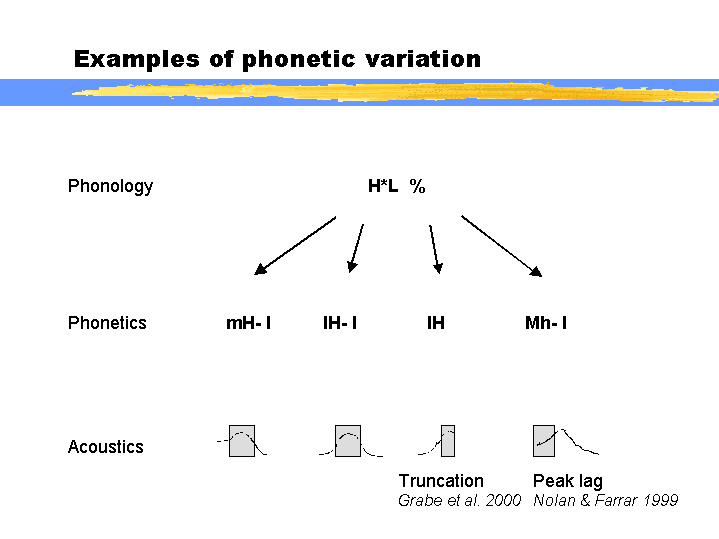
3.3.5 Examples
The following selection of labelling examples is sorted by direction of f0 movement from stressed syllable to immediately following syllable; this may be up, down, or level (IP initial options not given, self-explanatory). Note that the following examples represent a small selection of possible ID labels.
A. Levels
Stressed syllable in IP initial ID
|
up |
also up |
L-h |
Lh-h |
|
Down |
also down |
|
H-l |
Hl-l |
|
Level |
n.a. |
level |
n.a. |
|
up |
down |
level |
|
lH |
hL |
level |
Stressed syllable in IP medial ID
|
up |
.. |
.. |
.. |
.. |
.. |
.. |
.. |
lL-h |
lLh-h |
mL-h |
mLh-h |
hL-h |
hLh-h |
lM-h |
lMh-h |
|
down |
.. |
.. |
.. |
.. |
.. |
.. |
.. |
hH-l |
mHl-l |
mH-l |
etc. |
etc. |
etc. |
etc. |
etc. |
Label IDs as before from left to right, the second accent will have an accented syllable as the first pitch label, therefore capitalise and follow with left bracket to indicate that this is not a glide, i.e. a case where one stressed syllable is associated with two tones
For instance:
|
H* |
!H*L |
|
lH |
H[M-l |
|
P |
P |
|
the MEAL |
EARly |
Labels are aligned roughly in the middle of the vowel in the stressed syllables, and in the middle of the ID if there is no stressed syllable. Note that pitch labels should also be aligned with phonological labels on the tone tier.
The pitch movement transcription is given separately for each syllable which is
marked as rhythmically strong and accompanied by moving pitch (i.e. each accented syllable).
In other words, each ID is transcribed in isolation, and relationships between successive accents are
NOT taken into account (relationships between accents such as downstep are transcribed on the phonological level).
Back to the top
3.4 THE PHONOLOGICAL TIER
On the second highest tier, the intonational structure is labelled. Intonational phonology is a
controversial area of research, and there are no widely accepted tests for phonological
category membership of pitch patterns. In the IViE project, we draw up intonational
phonological systems for different varieties of British English on the basis of comparisons
of contours produced by different speakers in comparable contexts and produced with comparable speaker intent.
The resulting transcriptions are comparable across varieties because
(a) all pitch accents specifications are taken from a single pool of labels
(but not all labels or label combinations are used for every variety),
(b) all pitch accents are left-headed
(c) the system offers three rather than two boundary specifications
(some varieties of British English make use of two boundary tones,
but some have three different types of boundaries).
The following table shows the IViE tone labels:
|
IViE option |
Contour can look like this (description and possible tone target labels) |
|
H*L |
High target on prominent syllable followed by low target in same ID, e.g. H-l, mH-l or mHl-l |
|
H* |
High target, common in initial position in so-called flat hats, e.g. lH-h |
|
!H*L |
Downstepped high target, low target, e.g. hM-l |
|
L*HL |
IP internal or IP final rise-fall: Low target on prominent syllable, high target on next syllable followed by low target, e.g. lLh-l |
|
L*H |
Low target on prominent syllable followed by high target, e.g. mLh-h, mL-h, or lL-h |
|
L* |
Low target |
|
H*LH |
IP internal or IP final fall-rise: high target on strong syllable, low, high, e.g. mHl-h |
Intonation phrase boundary specifications:
|
Phrase-initial |
Phrase-final |
Transcribes: |
|
%H |
H% |
high target |
|
% |
% |
no pitch movement at boundary |
|
%L |
L% |
low target |
|
Extra Symbol |
Transcribes: |
|
# |
Hesitation, interruption |
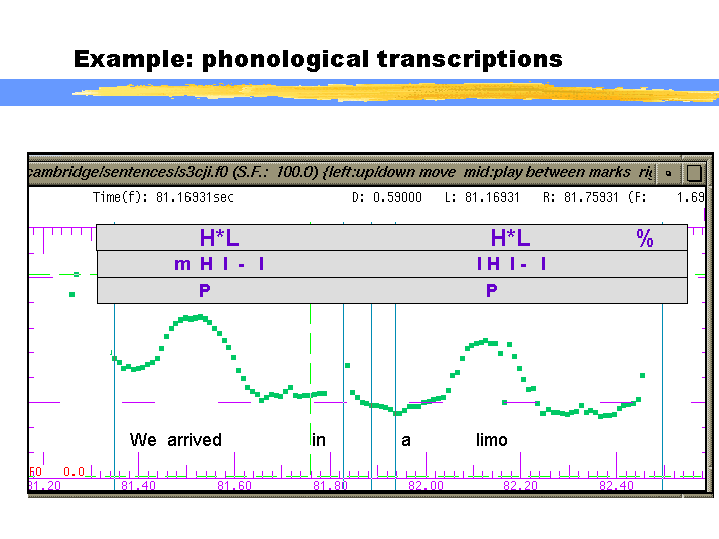
NB: The % boundary specification in IViE has been taken from Grabe (1998a NB. transcribed as 0% in
Grabe 1998a, but the 0 has been omitted). A % boundary symbol means that the
tonal specification on
the last syllable in the intonation phrase does not differ from the immediately preceding tone.
In practise, a % specification says: here we have a relevant landmark in the contour, i.e. an
intonation phrase boundary, and we know that, e.g. because there is a rhythmic continuity, and phrase-final
lengthening, but nothing is happening in the tonal domain. The pitch level reached at the end of the IP-final accent
continues at the same level. As nothing has changed, no tone is specified.
% boundary specifications offer transparent transcriptions of the rise-plateau patterns found in Northern
Irish English:
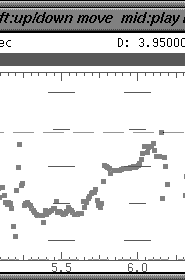 |
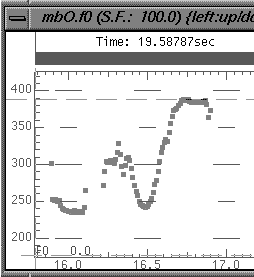
|
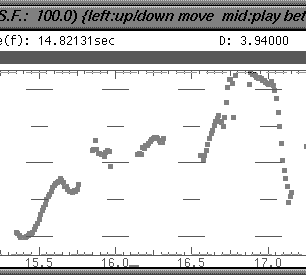
|
|
L*H H% |
L*H % |
L*H L% |
|
...the right of the lamb. (.wav) |
d'you know where the alleyway is? (.wav) |
...there is a library! The relevant bit is right at the end of the pitch trace; the rising-levelish-falling section. (.wav) |
Beckman, M. and Elam, G. A. (1997). Guidelines for ToBI labeling, version 3. Linguistics Department, Ohio State University.
Cruttenden, A. (1996). Intonation. Cambridge, CUP.
Fletcher, J., Grabe, E., and Warren, P.
(to appear, preprint in .doc format).
Intonational variation in
four dialects of English: the high rising tune. In Sun-Ah Jun (ed) Prosodic typology and
transcription - a unified approach. To be published by OUP.
Grabe, E. (1997). Comparative intonation analysis: English and German.
In A. Botinis, G. Kouroupetroglou and G. Carayannis (eds.)
Proceedings of the ESCA Tutorial and Research Workshop on Intonation: Theory, Models
and Applications. Athens, Greece.
Grabe, E. (1998a). Comparative Intonational Phonology: English and German.
MPI Series 7, Nijmegen, The Netherlands.
Grabe, E. (1998b). Pitch accent realisation in English and German.
Journal of Phonetics 26, 129-144.
Grabe, E., Post, B. and Nolan, F.
(to appear, preprint in .doc format). Modelling intonational Variation in English.
The IViE System. In Proceedings
of Prosody 2000, 2-5 October, Krakow, Poland.
Grabe, E., Nolan, F., and Farrar, K. (1998).
IViE - a Comparative transcription system for intonational variation in English.
Proceedings of the 5th Conference on Spoken Language Processing (ICSLP),
Sydney, Australia.
Grabe, E., Post, B., Nolan, F., and Farrar, K. (2000).
Pitch accent realisation in four varieties of British English.
Journal of Phonetics 28, 161-186.
Gussenhoven, C. (1984). On the grammar and semantics of sentence accents.
Dordrecht: Foris.
Ladd, D. R. (1996). Intonational phonology. Cambridge: CUP.
Nolan, F. and Grabe, E. (1997).
Can ToBI transcribe intonational variation in the British Isles?
In A. Botinis, G. Kouroupetroglou and G. Carayannis (eds.)
Proceedings of the ESCA Tutorial and Research Workshop on Intonation: Theory, Models
and Applications. Athens, Greece.
Nolan, F. and Farrar, K. (1999). Timing of f0 Peaks and Peak Lag.
Proceedings of the International Congress of Phonetic Sciences, 961-967.
Silverman, K., Beckman, M. E., Pitrelli, J., Ostendorf, M., Wightman, C., Price, P.,
Pierrehumbert, J., and Hirschberg, J. (1992).
ToBI: a standard for labeling English prosody.
In Proceedings of the Second International Conference
on Spoken Language Processing (ICSLP), 2: 867 - 70. Banff, Canada.
![]()
Comments and suggestions welcome
- Last modified on 3/09/2001 -